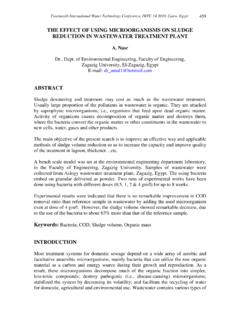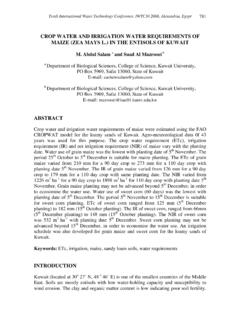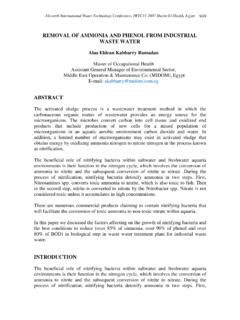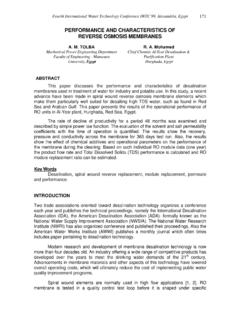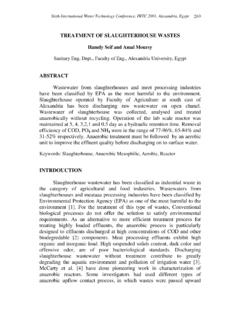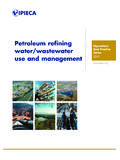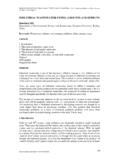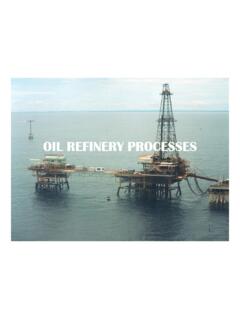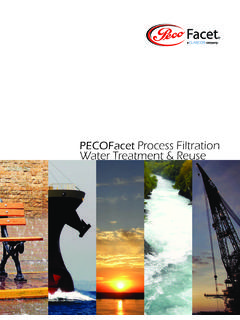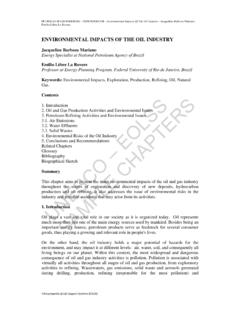Transcription of USING A NATURAL COAGULANT FOR TREATING …
1 Eighth International water Technology Conference, IWTC8 2004, Alexandria, Egypt 781 USING A NATURAL COAGULANT FOR TREATING wastewater A. M. Abdelaal Faculty of Petroleum and Mining Engineering Suez Canal University, Suez, Egypt ABSTRACT One of the major sources, which wastes the environment is the wastewater produced from the human activity. At present, in order to decrease waste hazards and to restrict the resulted effects on the environment, investigators studying the possibility of USING new methods and materials to treat wastewater . Coagulation and flocculation process are physical-chemical methods that widely used in the treatment of wastewater . Today, the prime concern of the environmental engineers is how to lower the coagulants and flocculants cost and to improve the characteristics of the produced sludge for safe utilizing.
2 In this work, it is tried to use bentonitic clay as a solid NATURAL COAGULANT . The study was carried out on two types of wastewater . The first was acidic wastewater from mining characterized as water clarity from 15-20 %, COD mg/l pH , SS mg/l and some heavy metals; the second was oily wastewater characterized as water clarity - %, g/l, SS of 300 mg/l, and oil products of g/l. Some chemicals were also used in this study; they were cationic type flocculants of high molecular weight with the bentonitic clay as COAGULANT and constant pH of at temperature of 25 C. The process accomplished in a number of systems by Jar test and evaluated by measuring the water clarity, COD, oil content and percent of SS removal.
3 The obtained results indicated that, USING bentonite as a COAGULANT not only effective and economical but also, encapsulated toxic matters inside the crystals of bentonite and that makes it environmental permit compliance. INTRODUCTION As known, the sewages are produced from oil refining, water mines, petrochemical plants, organics of synthesizing plants, coke-chemical etc. contains different amounts of harmful and toxic matters. These are the major sources, which wasting our environment. The most harmfully of these sewage matters mainly in oxidizing processes, owing to degradation of water oxygen, which a one of the water contents and this lead to increasing the biochemical oxygen requirements and that can be expressed by BOD (biochemical oxygen demand) index of water or COD (chemical oxygen demand) in mg/l [1,2].
4 In addition, it was recognize that, TREATING industrial sewages and wastewater by USING coagulants and flocculants at different types and dosages reduces toxic matters from these wastes [3, 4]. But the big problems are the chemicals cost and the sediments that produced from the process and its bad effects on the water resources, especially when the sediments contain high levels of toxic matters as COD, phenols, oils, heavy metals, ..etc [5]. Many materials used to absorb contaminants from wastewater . Clay-based treatment products are available at a low Eighth International water Technology Conference, IWTC8 2004, Alexandria, Egypt 782 cost, typically bentonite clay modified with various polymers and chemicals.
5 Bentonite clay can treat oil, sulfate, phosphate, and metals and is extremely effective at removing certain cationic components from wastewater . Bentonite has a remarkable affinity for metals, particularly heavy metals in solution [6, 7, 8, 9, 10]. Bentonite is also used frequently in TREATING waters containing heavy color, low turbidity. In addition to its weighting action, also benefit obtained from the known ability of clays to adsorb organic compounds. Furthermore, the addition of clay to a low - turbidity water provides increase opportunity for particle collisions, resulting in rapid formation of settleable floc [5]. The resulting mass (floc) is a complex mixture of encapsulated contaminants and clay solids held together by Van der Waals and electrostatic forces.
6 The contaminants are microencapsulated and surrounded by a barrier of clay particles making it nonreactive to external leaching [9]. A prime concern of the environmental engineer today, is how to lower the coagulants and flocculants cost and at the same time to improve the characteristics of the produced sludge to be safely utilized. To overcome this problem it was attempted to use bentonite clay in this work as a COAGULANT with the flocculants to treat two types of wastewater . MATERIALS AND METHODS Materials The wastewater samples used in this study are characterized as shown in Table 1: TABLE 1. wastewater samples characteristics The chemical reagents are used with bentonite clay in this study were as follows: ferric sulfate as COAGULANT ; cationic type-high molecular weight (Zetag32) and anionic type-high molecular weight (Praestol2515) as flocculants; H2SO4 and NaOH as pH modifier.
7 Method The study was carried out by the Jar test standard method USING a 1-liter wastewater and then its pH measured and adjusted to be around Conditioning time for coagulants was 3 min and 30 seconds for flocculants at 350 rpm, and then 9 min for Characteristics Sample type water clarity (%) COD (mg/l) SS (mg/l) Oil products (mg/l) Heavy metals &Sulfates pH 1 15 colored 193 - yes Mine wastewaters 2 20 colored 27 - yes Oily wastewater 3 colored 77000 300 9000 yes Eighth International water Technology Conference, IWTC8 2004, Alexandria, Egypt 783 flocculation at 50 rpm and settling time 3 min. To evaluate the results, we measured water clarity by USING the standard Colorimeter method, COD by USING Titration method, oil content by USING Chromatographic method, pH by pH-meter and SS removal by filtration and drying method.
8 The results and discussion are shown below. RESULTS AND DISCUSSION Results of the mining wastewater samples treatment In this section, the effects of traditional COAGULANT with flocculant on the mining wastewater treatment were investigated and the results compared with that produced from the studying of bentonite as a COAGULANT in conjunction with the same flocculant. The obtained results from the application on both types of wastewater are shown in Figures 1, 2, 3 and 4 below. Figure 1 illustrates the obtained results from the treatment of the first mine- wastewater sample. The figure specifies the effects of varying the dosages of ferric sulfate alone and the effects of cationic type, high molecular weight flocculant (Zetag32) with 5 mg/l ferric sulfate or with g/l bentonite at pH around and temperature 25 C.
9 FIGURE 1. The effects of flocculant (Zetag32) with a traditional COAGULANT , and with bentonite as a COAGULANT on treatment of the first mine- wastewater sample. 010203040506070809010002468101214161820 FLOCCULANT ADDITION, mg/lWATER CLARITY, %010203040506070809010002468101214161820 22 FERRIC SULFATE ADDITION, mg/lWATER CLARITY, T %Zetag 32 + g/l Bentonite Zetag 32+ 5 mg/l ferric sulfateFerric sulfate onlyp H = water Colored water Eighth International water Technology Conference, IWTC8 2004, Alexandria, Egypt 784 These results show that, USING ferric sulfate alone reveals a reverse effect on the clarity of water , where it decreases dramatically by increasing the dosages of ferric sulfate.
10 These decreases may be due to the presence of positive ions of Fe in wastewater ( mg/l) and others (Na, K, As, Cu, Hg, Zn, Mn, Pb, Cd, Co, Cr and Ni) that would inverse the action of the COAGULANT due to the increasing of the positive ions, which leads to intensifying the water turbidity. However, the obtained results from applying the cationic flocculant with ferric sulfate reveals insignificant increases in water clarity by increasing flocculant dosages, and the maximum clarity achieved at 18 mg/l flocculant was only about 22 % colored water . These insignificant increases may be due to the flocculant enmeshment (sweep-floc coagulation) produced from overdosing of the flocculant, which tends to give fairly thick layers around the suspended solids, and therefore produces the most marked effects.
